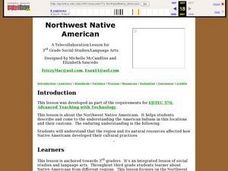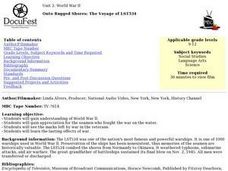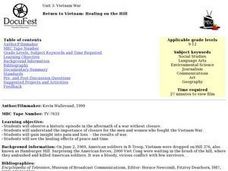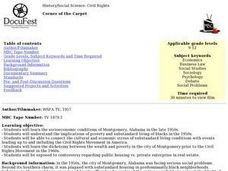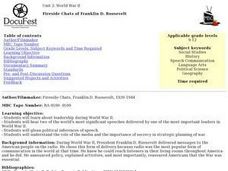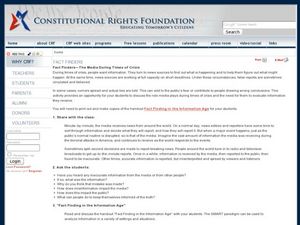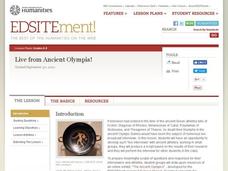Curated OER
Inventors of New England
Students examine the ways that technology effects our daily lives. Students also identify the processes involved in designing new technology.
PBS
The History and Use of Sampling Methods
Young mathematicians define population, draw convenience sample from the population, draw quota sample from the population, and draw random probability sample from the population. They explain why a random probability sample usually...
Curated OER
Freedom by the Fireside: The Legacy of FDR's "Four Freedoms" Speech
Students read and analyze Franklin Delano Roosevelt's 1941 State of the Union Address. They listen to recordings of speeches by F.D.R., answer discussion questions, and participate in a debate.
Curated OER
Northwest Native American
Third graders describe and come to the understanding the American Indians in this locations and their customs. They explain that the region and its natural resources affected how Native Americans developed their cultural practices.
Curated OER
Appalachia
Students investigate the benefits of dance and participate in dances. In this dance activity, students investigate a number of dances such as square dancing and clogging that are native to Appalachia. They use math concepts to determine...
University of Wisconsin
Getting the Word Out
An appropriate way to celebrate and conclude the construction of a rain garden is to share it with the community. Small groups collaborate to design an outreach product such as a PowerPoint presentation, brochure, or poster, to draw...
Curated OER
Outo Rugged Shores: The Voyage of LST534
Students view a film about warships during World War II. They discover the job of a seaman and what impact veterens have on the world today. They also examine the lasting effects of the war.
Curated OER
Return to Vietnam: Healing on the Hill
Students view a film about soldiers returning to Vietnam years after the war. They discover the need of closure by the soldiers because the war was not won. They examine the results of the war and answer questions to complete the lesson.
Curated OER
Corner of the Carpet
Students examine the socioeconomic conditions in Montgomery, Alabama in the late 1950's including the poverty and living condition of the blacks during this time by watching a documentary. They determine how these living conditions lead...
Curated OER
Chicago Rhythms, Chicago Roots
Students view a video about different types of music. They examine the history of jazz, big band and rock back to the city of Chicago. They discover Chicago's music scene today and compare it to the past.
Curated OER
Chicago On Stage
Young scholars view a film about the genres and disciplines of performing arts. They examine the theatre community in Chicago and the origins of theatre companies. They answer questions and discuss them to end the lesson.
Curated OER
Colors of Gray
Students view a film about theatres in Chicago. They discover how performing arts can be enjoyed by all ages and how one becomes involved in performing in theatre. They answer questions and discuss to end the lesson plan.
Curated OER
Fireside Chats of Franklin D. Roosevelt
Young scholars view a film about Franklin D. Roosevelt and his fireside chats. THey identify political inferences in his speeches and how the media played an important role in the war. They answer questions to complete the lesson.
Curated OER
Theory of Codes
Students explore the concept of code theory. In this code theory lesson, students discuss noise, error correction, Hamming distance, parity check matrices, and cyclic codes. Students develop these concepts through practice and discussion.
Curated OER
Space Science:Wherever You Go, There You Are
Students explore navigation principles by observing, measuring, and interpreting data to determine locations. Using a compass, compass rose, and a transit, they plot courses and discover the workings of the Global Positioning System...
Curated OER
Creativity in Science
Students view a video segment and discuss the technology and preparation that go into a satellite launch. They identify data that satellites can provide and consider how many people are involved in a satellite launch.
Curated OER
Fact Finders—The Media During Times of Crisis
Learners practice finding reputable facts. In this media awareness lesson, students review a handout regarding tips for evaluating media and then discover the SMART method which they use to analyze news sources and media.
Curated OER
War and the Media Fact Finders: The Media in Times of Crisis
Pupils explore the role of the media in war reporting. In this information age lesson, students discuss how to find and disseminate factual information. Pupils consider the source, motive, authority of information.
Curated OER
What's the Weather Forecast?
Students create a radio announcement based on the book Cloudy with a Chance of Meatballs. In this radio announcement lesson plan, students discuss the type of language used in other announcements and create their own.
Curated OER
Survival: The Human Body in Extreme Environments
Students create a list of signs the human body gives during threatening weather conditions. They investigate the causes and conditions of dehydration, overheating, and hypothermia.
Curated OER
Book Ads
Students observe book ads from Reading Rainbow and decide on a book to write an ad for. They prepare an ad and produce it using a digital camcorder and software.
Curated OER
Live from Ancient Olympia!
Middle schoolers study online resources to examine the ancient Olympic Games and athletes. They investigate the qualities of ancient Olympic athletes and role interviews with the athletes.
Curated OER
Book Advertisements
Students engage in the practice of producing a report about favorite books. The show Reading Rainbow creates context for this lesson. The making of an iMovie is done to present the book as an advertisement for the whole class.
Curated OER
Staying Informed
Students identify the various ways the American public can stay informed on the news. In groups, they brainstorm reasons why the public should not stick to one source for their news. They use this information to examine their own current...





